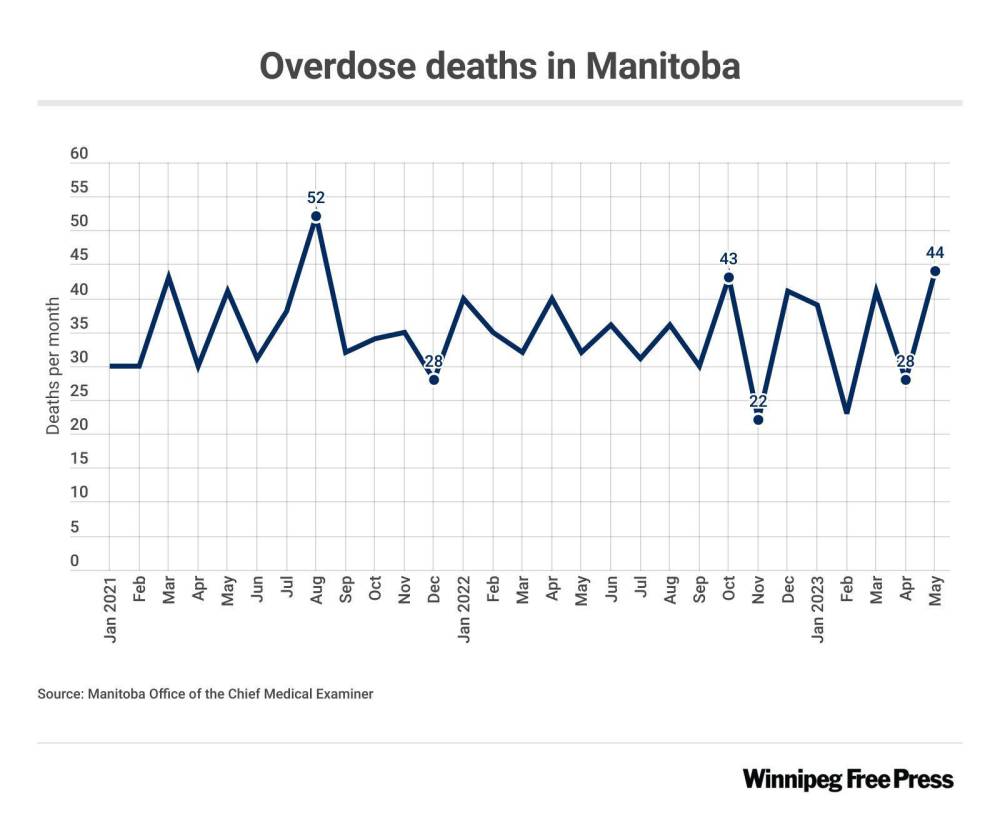New approach needed to fight toxic-drug OD crisis: harm-reduction advocates
Advertisement
Read this article for free:
or
Already have an account? Log in here »
To continue reading, please subscribe:
Monthly Digital Subscription
$0 for the first 4 weeks*
- Enjoy unlimited reading on winnipegfreepress.com
- Read the E-Edition, our digital replica newspaper
- Access News Break, our award-winning app
- Play interactive puzzles
*No charge for 4 weeks then price increases to the regular rate of $19.00 plus GST every four weeks. Offer available to new and qualified returning subscribers only. Cancel any time.
Monthly Digital Subscription
$4.75/week*
- Enjoy unlimited reading on winnipegfreepress.com
- Read the E-Edition, our digital replica newspaper
- Access News Break, our award-winning app
- Play interactive puzzles
*Billed as $19 plus GST every four weeks. Cancel any time.
To continue reading, please subscribe:
Add Free Press access to your Brandon Sun subscription for only an additional
$1 for the first 4 weeks*
*Your next subscription payment will increase by $1.00 and you will be charged $16.99 plus GST for four weeks. After four weeks, your payment will increase to $23.99 plus GST every four weeks.
Read unlimited articles for free today:
or
Already have an account? Log in here »
Hey there, time traveller!
This article was published 02/10/2023 (781 days ago), so information in it may no longer be current.
Manitoba has recorded its deadliest month for drug overdoses in nearly two years, sparking calls for the province to fundamentally change the way it battles the crisis a day before voters elect a new government.
There were 44 reported drug-related deaths in May, the most recent data available. The last time Manitoba saw more overdose deaths in a month was in August 2021, when 52 people died as a result of substance use.
The numbers are distressing but not surprising to local support groups, which began sounding alarms over a “perfect storm” of factors early in the summer, historically when there is a higher prevalence of street-drug use.
Opioid-reversal drug naloxone distribution from the province began to dry up in May — officials cited supply-chain issues as the reason — exacerbating the situation. And, at the time, the street-drug supply increasingly included traces of xylazine, a veterinary-use tranquilizer that makes users less responsive to naloxone.
Some, such as Resource Assistance for Youth director of grants and information Breda Vosters, had warned at the time that more drug-related deaths were all but imminent.
Vosters called May and the summer months of 2023 a “nightmare” for both vulnerable people and support workers who were overwhelmed by the level of need in the community.
“I wish that we didn’t need the data also for community organizations to be trusted and believed and listened to, and for community members to be listened to, when we’re saying that these things are a major problem, and that we need more resources,” she said Monday.
According to data collected by the City of Winnipeg, there were 333 recorded incidents where naloxone was administered to a patient one or more times in May, compared to 317 in June and 356 in July, while organizations were struggling to maintain supply.
“Definitely, I think, if we were able to get more naloxone out on the streets, even having one of those deaths be a reversal instead of a death would have been so worth it,” Vosters said. “And I’m sure that would have been the case.”
Tackling the toxic drug crisis has been a dividing line on the campaign trail. While the NDP and Liberals have promised the implementation of a safe, supervised consumption site and harm-reduction policies, Premier Heather Stefanson’s Progressive Conservative government has focused on promising funding for more withdrawal beds and treatment services.
The issue has also had its place in advertisements leading up to the election, including one paid for by the Tories in the Monday edition of the Free Press that includes an indictment of NDP MLA Bernadette Smith’s support of safe consumption sites as wanting to “give away hard drugs just like the NDP in B.C.”
Reducing the number of deaths has to start with fundamentally changing the way the provincial government approaches the drug crisis, Manitoba Health Coalition’s provincial director Thomas Linner said.
“I don’t think it’ll be easy for any government,” he said. “There are deeply ingrained prejudices… This is touching people in Thompson, and Treherne and Tuxedo.”
Linner said the Tories’ stance will be remembered unkindly.
“It is remarkably sad that the current government has so politicized this issue that we come to this state… with them running against any of the measures that could potentially help make a difference,” he said.
“I believe that we will look back upon this government’s approach to the toxic drug-supply crisis and to harm reduction as its greatest failure.”
malak.abas@freepress.mb.ca

Malak Abas is a city reporter at the Free Press. Born and raised in Winnipeg’s North End, she led the campus paper at the University of Manitoba before joining the Free Press in 2020. Read more about Malak.
Every piece of reporting Malak produces is reviewed by an editing team before it is posted online or published in print — part of the Free Press‘s tradition, since 1872, of producing reliable independent journalism. Read more about Free Press’s history and mandate, and learn how our newsroom operates.
Our newsroom depends on a growing audience of readers to power our journalism. If you are not a paid reader, please consider becoming a subscriber.
Our newsroom depends on its audience of readers to power our journalism. Thank you for your support.









